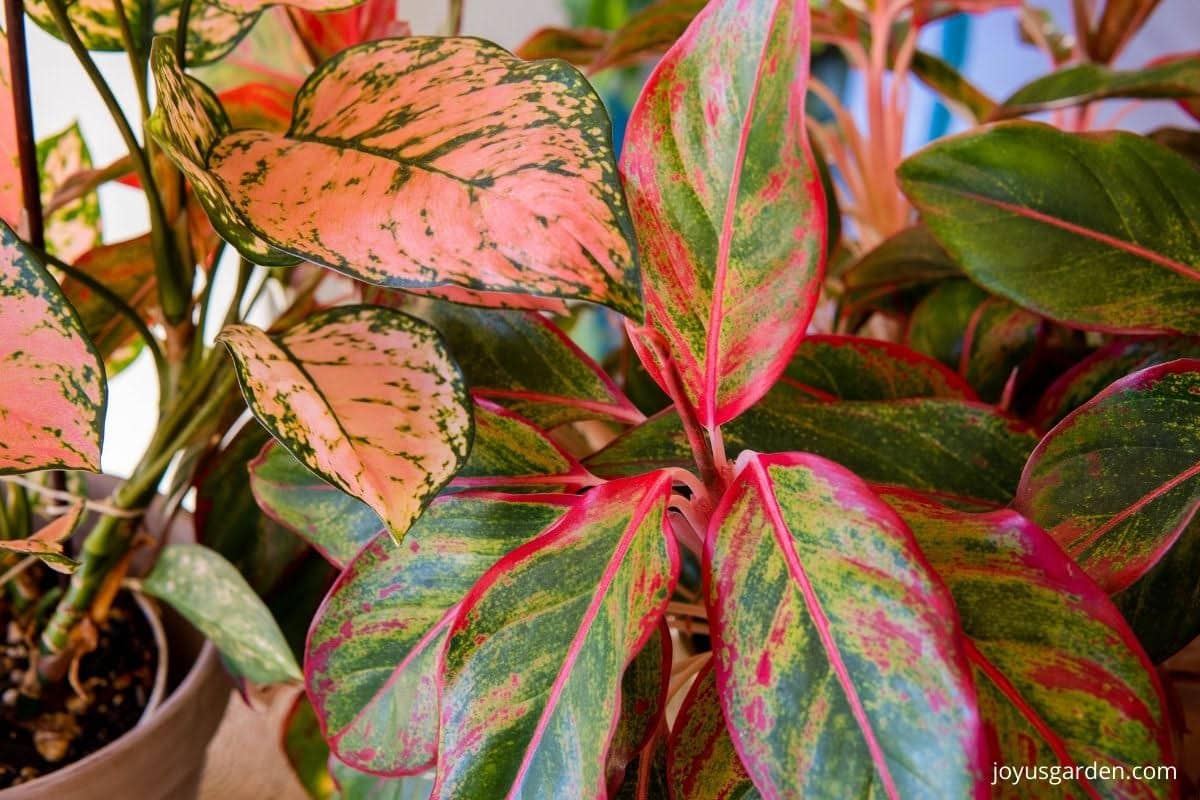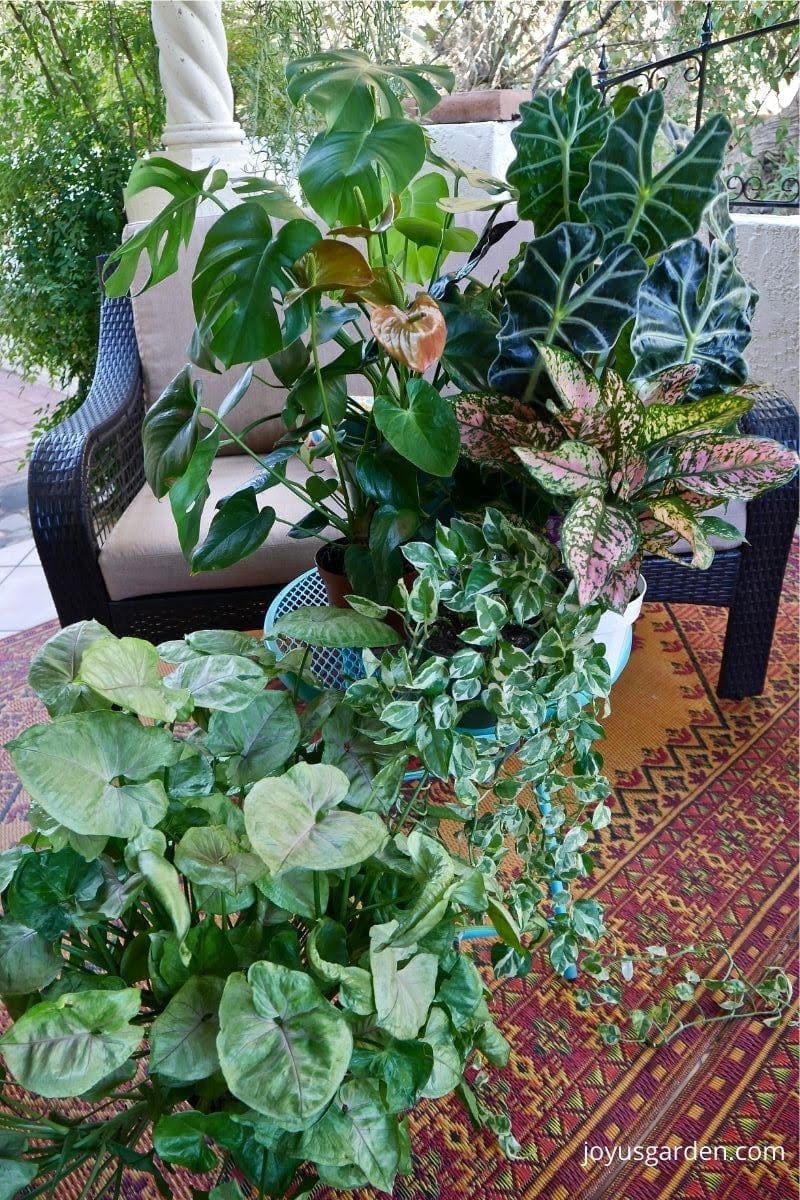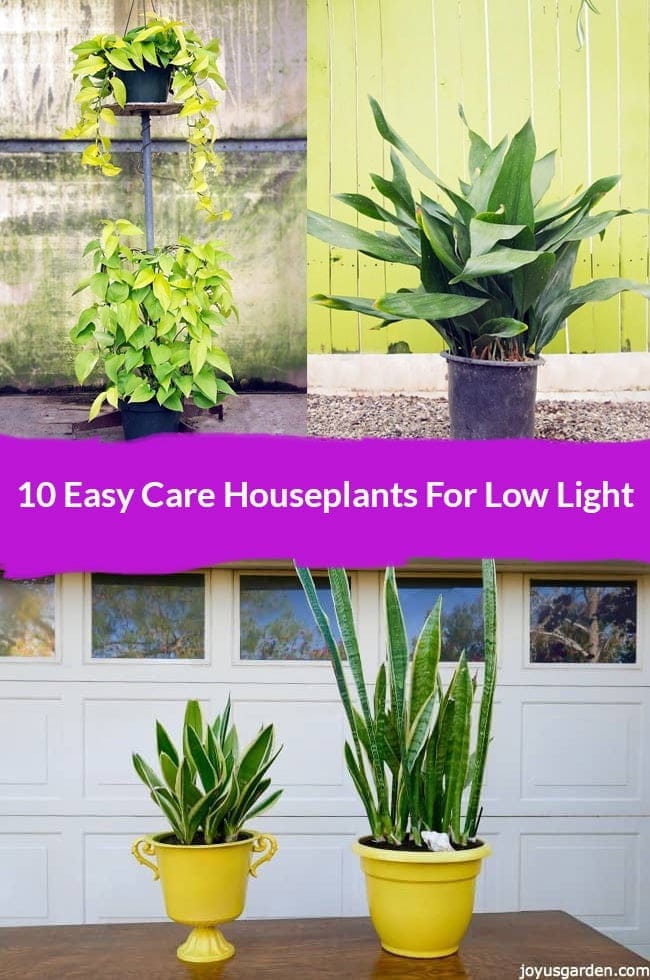Aglaonema Lady Valentine: Pink Aglaonema Care Tips
Aglaonemas are fundamental in the houseplant world because of their lush greenery, gorgeous foliage, and pops of color. Here’s a guide on how to care for Aglaonema Lady Valentine (Pink Agalonema) with growing tips and frequently asked questions answered at the end.
There are many beautiful Aglaonema varieties with pink tones on the market and this is obviously one of them.
Other common names for this plant are Pink Lady Aglaonema, Pink Valentine Agalonema, Pink Valentine Plant, Aglaonema Valentine, Aglaonema Pink, and Pink Chinese Evergreen.
Other pink aglaonema varieties include Pink Splash, Siam Pink, Two Tone Moonstone, Ultra Pink, Prosperity, Crete, Prestige, Sparkling Sarah, Pink Princess, and Pink Dalmatian Aglaonema.
I’ve heard mine called Pink Aglaonema and I usually refer to it as my “Pink Ag”. In my experience over the years, the care for these aglaonemas with colorful foliage is much the same, just like my Aglaonema Siam Aurora.
Pink Agalonema Traits

This colorful plant sits on a long table in my dining room with many other houseplants.
Some who see it on social media repeatedly ask “What is the name of the pink one?“. You asked so a care post is coming your way.
Size
Lady Valentine Aglaonemas are most commonly sold in 6″ grow pots. Also, in 4″ and 8″ pots.
I’ve had mine for 3 -1/2 years now and it’s still in the 6″ pot I bought it in. It stands 25″ tall (pot included) x 32″ wide.
Growth Rate
Most aglaonemas are known to be slow-growing plants. Mine is in a very bright exposure and has been growing moderately.
As with any indoor plant, the lower the light, the slower the growth rate will be.
Uses
These are tabletop plants. I’ve seen them used in dish gardens too.
I already have a general guide on Agalonema Care. I wanted to do one specifically on the Pink Aglaonema because it’s quite popular and you’re obviously curious about it. This is one stunning foliage plant!

Aglaonema Lady Valentine Care
Pink Aglaonema Light Requirements
Aglaonemas, mainly the dark-leaved and/or greener Chinese Evergreens, are billed as low-light plants.
This is where Lady Valentine differs from some of the other Aglaonmeas known for their tolerance of low light conditions.
I’ve found that the dark leaf varieties, like my Aglaonema commutatum Emerald Beauty (oftentimes called Aglaonema Maria) pictured in the middle in the photo below or the popular Aglaonema nitidum and Aglaoenam Silver Queen can tolerate lower light conditions much better than this one.
The Pink Agalonemas and others that have more color and brightness in their foliage (like my Siam Aurora pictured on the right below) need medium to high light to do and look their best. Bright indirect sunlight is what they like.
This plant will do fine in high-light conditions as long as it’s kept a few feet away from windows with the strong sun coming in. That, along with touching the hot glass, will burn it in no time flat.
Most importantly in regards to light, is that this plant doesn’t do well in lower light conditions and will lose coloration (turn greener rather than pink), the leaves will be smaller, and the plant will grow slower if at all.
That’s your cue to move it to a bright spot with indirect light.
Mine sits on the long table about 6′ from a trio of windows with a southern exposure. I live in the Arizona desert where the sun is intense and the sunny days are plentiful.
The color of my plant is strong and it flowers once or twice a year. It likes this spot but I do need to rotate it every couple of months so it gets light on all sides.
I get asked about growing plants in artificial light and I have no experience to share on this subject because I’ve always grown my indoor plants in natural light.
You may have to move your Lady Valentine to a brighter spot in the winter months so it gets the light it needs. Here are more tips on Winter Houseplant Care.

Pink Aglaonema Watering
I water mine when it’s almost dry. Here in the desert during the warm months, it’s every 5-7 days, and in the winter months, every 10-14 days.
I really can’t tell you how often to water your Pink Aglaonema because there are many variables that come into play.
Here are a few: the pot size, the type of soil it’s planted in, the location where it’s growing, and your home’s environment.
Don’t keep your plant too wet or it’ll ultimately succumb to root rot. It’s best if the pot has a drainage hole (or more) as this allows the excess water to flow out and prevents it from building up in the bottom of the pot.
If your plant is showing brown leaf tips, it may be due to the high mineral content in your tap water. A solution would be to try using 1/2 tap water and 1/2 purified water.
Here in Tucson, the water is hard. I used purified water before I got a tankless R/O system installed in my new home. It has a re-mineralization cartridge that puts the good minerals back in. This is what I use to water all of my indoor plants.
New to indoor gardening? You’ll want to check out this Indoor Plant Watering Guide as it has many more details on this subject.
Temperature
If your home is comfortable for you, it’ll be so for your indoor plants also.
Be sure to keep your aglaonema out of any cold drafts as well as away from air conditioning or heating vents.
Humidity
Aglaonemas are native to the subtropical and tropical regions of Asia.
Despite the fact that they prefer high humidity, they’re fairly adaptable. They do fine in our homes which tend to have dry air.
I live in the Arizona desert and my Lady Valentine Aglaonema has no brown leaf tips which is typically a reaction to dry air.
My Red Aglaonema and A. Silver Bay are mostly tip free also. My A. Emerald Beauty on the other hand is full of brown leaf tips.
I have a humidity meter in my dining room. I run my humidifiers when the humidity reads low, which is almost all the time here in the Arizona desert!
I have a large, deep kitchen sink. Once a month I take it to the sink, spray the foliage, and leave it in there for an hour or so to temporarily up the ante on the humidity factor. It also helps to keep the foliage clean.
If you think yours look stressed due to lack of humidity, here are a couple of other things you can do. You can try using a pebble tray or fill the saucer your plant sits on with pebbles and water.
Put the plant on the pebbles but make sure the drain holes and/or the bottom of the pot aren’t submerged in water.
Misting your plant a few times a week will help too.
Do you have a lot of tropical plants? We have a whole guide on Plant Humidity that might interest you.

Fertilizer / Feeding
Every other spring, I give the majority of my houseplants a light application of worm compost with a light layer of compost over that. Easy does it – a 1/4 ” layer of each is enough for a 6″ size houseplant. It’s strong and breaks down slowly.
Read about my Worm Compost/Compost Houseplant Feeding right here.
I give my Aglaonema Lady Valentine a watering with Grow Big, liquid kelp, and Maxseafive to seven times during the growing season.
By the way, I alternate these liquid fertilizers and don’t use them all together.
I fertilize my indoor plants starting in mid-February through October. We have a long growing season here in Tucson and my houseplants appreciate it.
When my plants are putting new growth and new leaves, it’s my sign to start feeding. For you in a different climate zone with a shorter season, feeding two or three times per year may do it for your plants.
Don’t give them too much fertilizer or too often because salts can build up and eventually burn the roots of the plant. This will show up as brown spots on the leaves.
If you fertilize more than 3 times a year, you can try using the fertilizer at half-strength. The label on the jar or bottle will guide you.
Avoid fertilizing a houseplant that is stressed, ie. bone dry or soaking wet.
Be sure to check out our Guide To Fertilizing Indoor Plants for lots more info.
Best Soil For Aglaonema
All Chinese Evergreen plants will appreciate good quality potting soil formulated for indoor plants. I alternate between Happy Frog and Ocean Forest and sometimes I mix them together.
They’re high quality and have lots of good stuff in them. You can use both for your outdoor container plants too (except succulents).
Aglaonemas, like other indoor plants, don’t like a heavy mix. You want it to be well-draining and well-aerated.
Add in pumice or perlite to lessen the chance of rot.
Healthy soil will ensure a healthy plant. The aglaonema mix recipe I use is 3 parts potting soil to 1 part pumice.
You can add a bit more pumice or perlite to the mix if it still needs lightening up.
I also add a few handfuls of coco coir and coco chips along with a couple of handfuls of compost/worm compost to the blend when I’m repotting Aglaonemas.
I have a lot of plants and a potting room off my garage so don’t worry about adding them if you’re short on space.
Repotting
Repotting is best done in spring or summer. Early fall is fine if you’re in a warmer climate like me. The faster your plant is growing, the sooner it’ll need repotting.
I repot my aglaonemas every 2-5 years unless they’re showing signs of stress, the soil looks depleted, or roots are coming out the drain holes.
Go up 1 pot size (as an example from a 6″ pot to an 8″ pot), and make sure there is at least 1 drainage hole so the excess water can easily flow out the bottom of the pot and not build up in the bottom.
I’ve done a Guide to Repotting Plants which I think you’ll find helpful, especially if you’re a beginning gardener.


Pruning/Trimming
Not much is needed. The main reasons to prune this plant are for propagation or to trim off the occasional lower yellow leaf or spent flower.
This plant tends to flop as it grows. I’ve tied mine up with jute string (and now clear ties) and stakes to keep the stems upright.
If the plant is getting too leggy or you want it to grow denser, then you can always tip prune off the new growth. Cutting the stems back should force out new growth at the base.
Speaking of a Lady Valentine plant getting leggy, they’re prone to growing long stems over time. It’s the nature of their growth to occasionally lose lower leaves. As more foliage forms at the top, they become a bit top-heavy.
If yours isn’t putting out new growth at the base to cover the stems like mine is, you can try pruning a couple of stems down leaving out 2-3 nodes above the soil line to force out new growth.
Just make sure your Pruners Are Clean & Sharp before you do any pruning.
Propagation
I’ve propagated aglaonemas by division and stem cuttings. My 6″ A. Siam Aurora could easily be divided into 2 plants.
If you’ve pruned leggy stems off, you can also try propagation via the stem-cutting method. Cut stems that are 4-10″ long and propagate them in a light mix or in water.
I take off the majority of lower leaves because they usually die anyway and new growth will eventually emerge.
I currently have Aglaonema Silver Bay cuttings rooted in water that are ready to be planted. I’ve rooted Aglaonema stems in water successfully but never got around to planting them in the soil because I gave them away.
I’m not sure how they transfer over from water into the soil for the long haul. I’ve heard both yes and no.

Pests
I worked in the interior landscaping trade for seven years. On commercial accounts, I saw agalonemas infested with mealybugs, spider mites, and scale.
I’ve talked about mealybugs, spider mites, and scale before so you can identify these pests and treat your plants accordingly to get rid of them.
Pests can travel from houseplant to houseplant fast and multiply like crazy so make sure you get them under control as soon as you spot them.
Pet Safety
Aglaonemas are considered to be toxic to pets. I consult the ASPCA website for my info on this subject and see in what way the plant is toxic. Here’s more info on this for you.
My kitties pay no attention to my numerous houseplants so it’s not an issue for me.
Looking for non-toxic houseplants? Here’s a list of 11 Pet-Friendly Houseplants for your reference.

Flowering
Oh yes, it does!
It has a spathe-type flower. My Agalonema Lady Valentine flowered this summer into early fall. The spathe is light green and the spadix (the center part) is white.
I’ve heard that it’s good to remove the flowers because they zap energy from the plant. I leave them on and haven’t found that to be true.
I cut the flower stems off (all the way down to the base) when the spathe and spadix are both dead. Maybe I’m missing something but I like to look at them!
Just know that if your plant is growing in lower light conditions, it’s unlikely it’ll flower.
Pink Agalonema Care Video Guide
Some Of Our General Houseplant Guides For Your Reference: Guide To Watering Indoor Plants, Beginner’s Guide To Repotting Plants, How to Clean Houseplants, Winter Houseplant Care Guide, Plant Humidity: How I Increase Humidity For Houseplants, Buying Houseplants: 14 Tips For Indoor Gardening Newbies
Aglaonema Lady Valentine FAQs
How do you care for a colored Aglaonema?
The care for the brightly colored Aglaonema plants is pretty much the same. Just remember that they need lots of bright, natural light to bring out and keep the color of those bright patterned leaves.
The Chinese Evergreen cultivars with silver-green or dark green leaves tolerate lower light levels.
Either by division or the stem cuttings method.
When the roots are growing out of the drainage holes is a good time. I’ve got the tip of 1 root growing out of a drain hole of mine so I’ll probably do it in a year. If your plant is looking stressed, one reason could be that it’s potbound or in need of fresh soil.
Repotting an aglaonema every 2-5 years is a general rule. Spring and summer are the best times of year to do it.
It’s most likely a watering issue – too much or too little.
All Aglaonemas do their best in bright natural sunlight but with no exposure to the direct hot sun. The varieties with less color (like my Ag Emerald Beauty and Ag Silver Bay) can tolerate lower light conditions.
Reference the above answer. Even the ones that tolerate lower light conditions will stop growing and become very spindly if the light level is too low.
In response to the 1st question, I can’t give you an exact schedule for watering your Aglaonema pink. There are many factors involved. For instance, my new home has a lot of windows and more light than my previous home. I water all my houseplants more often here.
In response to question 2, no. I let mine almost completely dry out before watering again.
Conclusion / 3 Important Things To Know
This colorful aglaonema isn’t a low-light plant. It needs bright natural light, a moderate to high exposure, to bring out and keep that beautiful pink foliage.
Occasionally, the lower leaves of this pink Chinese Evergreen will die – it’s the nature of how this plant grows. Tip pruning once a year can help your plant from getting too leggy.
As the foliage on top of the stems grows, it can become top-heavy. It also happens if the plant isn’t getting enough light. You can prune the stems if yours is flopping too much. I put a couple of stakes in my plant and ran jute string around the stems to hold the plant more upright.
Are you ready to get a Pink Aglaonema? This colorful houseplant is easy to care for and oh-so-eye-catching!
Happy gardening,








